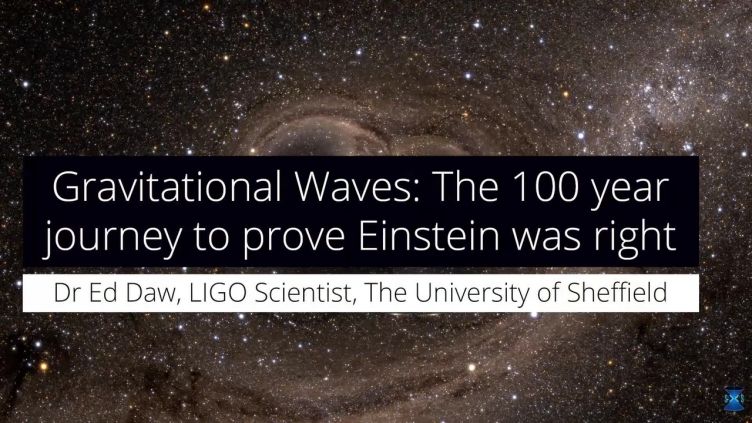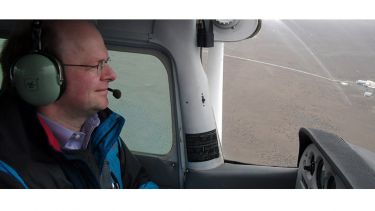For the first time, scientists have observed ripples in the fabric of spacetime called gravitational waves, arriving at the earth from a cataclysmic event in the distant universe.
This confirms a major prediction of Albert Einstein’s general theory of relativity made in 1915 and opens an unprecedented new window into the cosmos.
Gravitational waves carry information about their dramatic origins and the nature of gravity that until now could not be obtained.
Physicists have revealed the gravitational waves detected were produced in the final fraction of a second during the merger of two black holes, which produced a single, more massive spinning black hole. The collision of two black holes had been predicted but never observed before.
The gravitational waves were detected on September 14, 2015 at 5:51 am (Eastern Daylight Time) by both of the twin Laser Interferometer Gravitational-wave Observatory (LIGO) detectors, located in Livingston, Louisiana, and Hanford, Washington, USA.
Dr Ed Daw from the University of Sheffield’s Department of Physics and Astronomy is part of the LIGO Scientific Collaboration that made the discovery. He has been researching gravitational waves with LIGO since 1998.
"Discoveries of this importance in Physics come along about every 30 years," he said.
"A measure of its significance is that even the source of the wave – two black holes in close orbit, each tens of times heavier than the sun, which then collide violently, has never been observed before, and could not have been observed by any other method. This is just the beginning."
Based on the signals observed, Dr Daw and the collaboration of LIGO scientists estimate that the black holes, from which the gravitational waves were detected, were about 29 and 36 times the mass of the sun, and collided around 1.3 billion years ago.
The gravitational waves detected were about three times the mass of the sun which had been converted in a fraction of a second – with a peak power output about 50 times that of the whole visible universe.
According to general relativity, a pair of black holes orbiting around each other lose energy through the emission of gravitational waves, causing them to gradually approach each other over billions of years, and then much more quickly in the final minutes.
During the final fraction of a second, the two black holes collide into each other at nearly one-half the speed of light and form a single more massive black hole, converting a portion of the combined black holes’ mass to energy, according to Einstein’s formula E=mc2. This energy is emitted as a final strong burst of gravitational waves. It is these gravitational waves that LIGO observed.
Dr Daw, who has been studying gravitational waves as part of the LIGO Scientific Collaboration since 1998, explained: “Imagine that your TV had only ever received one channel on which the shows were all rather similar to each other.
"One day a second one appeared which shows completely different programs, like nothing that had ever been broadcast on the old channel. Wouldn’t you want to switch over?
"By detecting this signal, LIGO has effectively tuned into a new channel – a completely new way of observing the universe."
He added: "Gravitational waves are so completely different from light, we’re probably only just beginning to understand how they reflect and shape our universe.
"For example, a gravitational wave will propagate almost completely unaltered through entire planets, star systems, galaxies… this is so completely different from the radio waves that your mobile phone picks up – even getting too close to a building can disrupt those signals.
"Light, or more generally electromagnetic waves, are so much more vulnerable to interference than gravitational waves."
LIGO research is carried out by the LIGO Scientific Collaboration (LSC), a group of more than 1000 scientists from universities from 15 countries around the globe - including the University of Sheffield.
Professor Sir Keith Burnett, Vice-Chancellor of the University of Sheffield and eminent physicist, said: "I am stunned and totally delighted to hear that gravitational waves have been detected for the first time by a team that includes physicists from Sheffield.
"This gives us a unique way of seeing the most formidable and violent of gravitational phenomena in the universe. To have seen the ripples in spacetime generated by colliding black holes is a truly magnificent achievement.
"When I think of all the dedicated technical brilliance that has gone into this wonderful breakthrough I feel quite humble.”
He added: "The courage to work for many decades, with such profound technical challenges, guided only by Einstein's theory, deserves the greatest of scientific accolades.
"I have seen glimpses of the work that has gone into developing the extraordinary instrumentation that the physicists have used.
It has filled me with deep admiration for this achievement. We must salute these pioneers who have opened our new view of the universe."
The LIGO Observatories are funded by the National Science Foundation (NSF), and were conceived, built, and are operated by Caltech and MIT.
The discovery, accepted for publication in the journal Physical Review Letters, was made by the LSC (which includes the GEO Collaboration and the Australian Consortium for Interferometric Gravitational Astronomy) and the Virgo Collaboration using data from the two LIGO detectors.
The UK Minister for Universities and Science, Jo Johnson MP, commented on the announcement.
He said: "Einstein’s theories from over a century ago are still helping us to understand our universe. Now that we have the technological capability to test his theories with the LIGO detectors his scientific brilliance becomes all the more apparent.
The Government is increasing support for international research collaborations, and these scientists from across the UK have played a vital part in this discovery."



